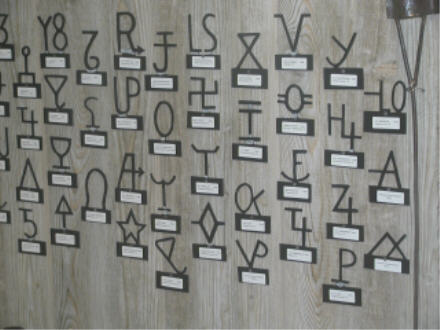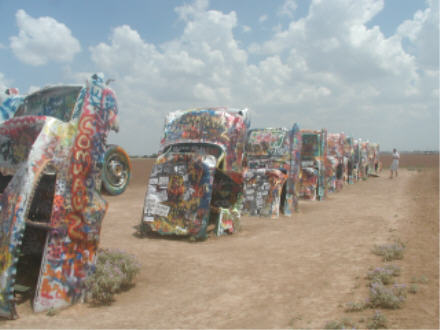The rural stretches of 66 in Oklahoma have a rhythm all their own -- the rhythm of wheels regularly ka-chunking over the slabs of reddish concrete laid decades ago to build the road. Another feature of this pavement wore out its welcome long ago: slanted rain gutters at the curbs which, if a car veers too far away from the center line, tend to flip the car over.
Today's first Route 66 landmark, the 38-span bridge across the South Canadian River, is soon followed by the tiny home/gas station inhabited for almost 60 years by the late Lucille Hamons. Until her death two years ago, Lucille welcomed Route 66 tourists with stories and scrapbooks. The house is empty, but visitors have erected a tribute on her lawn -- Burma-Shave styled signs proclaiming "To many a traveler/Kindness she showed/The mother of/The Mother Road/Lucille's." Swung by the Cherokee Trading Post for an infusion of tackiness, then bypassed both of Oklahoma's Route 66 museums to save a little time.

Across the state line in McLean, Texas, though, I stopped at the combination Route 66 and barbed wire museum. There are enough barbed wire collectors to support their own magazine and annual conventions...not to mention the dozens of doctors who benefit when the passionate barbed-wire collector accidentally rubs against part of his collection. Down the block, a mural depicts Elvis swiveling his hips before a microphone planted squarely in the middle of Route 66.
A few miles ahead in Groom, the 190' Largest Cross in the Western Hemisphere grows tackier and tackier. The original steel cross and Stations of the Cross have now been joined by a display of Jesus preaching atop a stream of running water (in front of which a thirtysomething woman was ecstatically undergoing some type of religious conversion or rebirth at the hands of two friends), an anti-abortion "Tomb for the Unborn," and a full-size replica of the Shroud of Turin, "thought by many to be the burial cloth of Jesus." If a Shroud of Turin is here, can displays of "the garage door on which Jesus' face appeared in the paint" be far behind? Capping the experience, a sign just outside the parking lot urges the hungry faithful to eat at the "Blessed Mary Restaurant" down the block.

Fortunately, Texas 66's most renowned secular landmark lay an hour to the west: Cadillac Ranch, 10 Cadillacs planted nose-down in a field. From there I passed the midpoint of Route 66 at Adrian, Texas, then turned my clock back as I crossed into New Mexico.
Most of the classic "66 images" come from Arizona and New Mexico. There's a reason. The towns are few and far between, the scenery is remarkable, and for the first time the traveler encounters towns which subsist almost entirely on tourist dollars. New Mexico even has a number of thriving Stuckey's among the dozens of businesses selling "genuine Indian goods," such as Navajo rugs, moccasins, and the omnipresent turquoise jewelry.
I was running a little late as I approached Albuquerque, but Mother Nature helped me catch up. Albuquerque's location on the west side of a mountain range can produce weird weather patterns -- like tonight's sudden, heavy thunderstorm with fierce easterly winds, which hit Albuquerque even as the sun continued to shine brightly in the western sky. I stopped in hopes of waiting it out, then tried with little success to photograph the resulting rainbow. By the time the skies were clearing, night was falling - tomorrow I'll double back about 20 miles to start the day's journey.
Go to the next day
Back to NEWS FROM THE ROAD menu
Back to ROADSIDEPHOTOS.COM home page